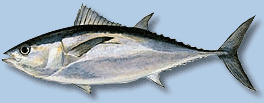Blackfin Tuna Facts
Scientific Classification of Blackfin Tuna: Thunnus Atlanticus
Kingdom of Blackfin Tuna: Animalia
Phylum of Blackfin Tuna: Chordata
Class of Blackfin Tuna: Actinopterygii
Order of Blackfin Tuna: Perciformes
Family of Blackfin Tuna: Scombridae
Genus of Blackfin Tuna: Thunnus
Species of Blackfin Tuna: T.atlanticus
Blackfin Tuna
These species are the smallest member pertaining to genus called Thunnus. These species are also known as Football, Blackfinned Albacore and Bermuda. Their look somewhat resembles the football. These species have a fighter attitude and this is what makes them survive amongst other aquatic creatures.
Pictures of Blackfin Tuna
Some Interesting Facts about Blackfin Tuna
- These species are sometimes misinterpreted as the yellowfin tuna or the blue fin tuna because of their size.
- These species have great fraternity with the skipjack tuna and can be often seen moving together.
- Amongst the other members belonging to the same family, these species are recognized as the best warriors.+
- These species have very powerful eyesight and are often taken as game fishes.
- These species are also found in some restricted areas of Atlantic Ocean.
Distribution of Blackfin Tuna
One can spot these species across the Western Atlantic Ocean including Gulf of Mexico, Carribean Sea and along southern portion of Brazil. Infact they like to inhabit temperate and tropical waters. They are also found in some region of Florida and sparsely in Massachusetts.
Identification of Blackfin Tuna
- In case of juvenile ones, some marks of pigmentation can be noticed in the dorsal fins. Infact the dorsal and the lateral portions have pigmentation that look like vertical marks.
- The intensity of gill rakers helps in distinguishing them from the other tuna fishes.
- The ventral portion of the liver that is red in color and the swim bladder also demarcates the blackfin tuna.
Description of Blackfin Tuna
- Color of Blackfin Tuna: These species possess a huge color mix over their body. The stomach is white colored while the back portion is dotted with blue and black color marked by a little of silver. The eyes have brown stripes with a golden row of silver or grey colors.
- Length of Blackfin Tuna: These sizes of these species vary from 28-30 cm. In rare cases it might even go to 100 cm. The size of the elder tuna reaches up to 50 cm. In fact their growth rate is sometimes 5 – 6 inches per month.
- Weight of Blackfin Tuna: These species usually weigh around 20 kg.
Behavior of Blackfin Tuna
- These species form large school of tuna with skipjack tuna on the ocean surface but are otherwise great rivals.
- They are very adamant by nature.
- Their feeding technique is quite different from others. They usually have food by chasing or catching them on water surfaces.
- They are always found in proximity to the water surfaces while feeding.
Food Habits of Blackfin Tuna
These species like to have shrimps, squids, crabs, amphipods and stomatopods in their diet. They form a good company with the skipjack tuna while hunting.
Habitats of Blackfin Tuna
These species are very common in the oceans. They like to dive in to the profound depths of water very close to the greens. These species like to inhabit in the pristine and warm waters as well. They move to the temperate portion where the temperature should be 20 degree Celsius while migrating.
Predators of Blackfin Tuna
The main predators of these species are the
- Blue marlins
- Dolphin fish
- Skipjack tuna
- Sea birds
Adaptations of Blackfin Tuna
These species are very aggressive and fast. This helps them in fortifying from their enemies. Their strong sight helps them to visualize the trap from far away. They also come together with other tunas to form a protective covering when they are attacked.
Migration of Blackfin Tuna
During summer these species move to the temperate water areas.
Reproduction of Blackfin Tuna
These species become sexually mature when they are of two years. However this varies among regions. They reproduce in the open areas during the periods of summer. These species lay the eggs in the water areas where the process of fertilization takes place immediately after mating with the sperm. The eggs of pelagic larvae can be seen only at a depth of 45-50 meters under water.
Nutritional Facts of Black Fin Tuna
The tuna is consumed largely by human beings. Each ounce of blackfin tuna (boneless) contains Total Fat 0.27 g, Sodium 10 mg, Cholesterol 13mg, Potassium 126 mg, Protein 6.63 g and Iron 1%.
Petting of Blackfin Tuna
- Proper Housing: Large sized tanks are required in order to allow free mobility.
- Proper Feeding: One should make sure to give them regular food and most importantly provide them with squids and other aquatic creatures.
- Proper Caring: One should also make sure that the temperature is above 20 degree Celsius and the water is clear.
Conservation Status of Blackfin Tuna
According to the reports of IUCN these species are not threatened.
